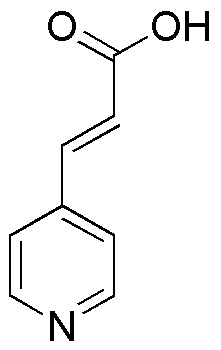4-Pyridineacrylic acid is widely utilized in research focused on:
- Pharmaceutical Development: This compound is often used as a building block in the synthesis of various pharmaceuticals, particularly those targeting neurological disorders due to its ability to interact with specific receptors in the brain.
- Agricultural Chemicals: It serves as a precursor for developing herbicides and fungicides, helping to enhance crop protection and yield in the agricultural sector.
- Biochemical Research: Researchers use it in studies related to enzyme inhibition and metabolic pathways, providing insights into cellular processes and potential therapeutic targets.
- Material Science: It is applied in the creation of polymers and coatings, leveraging its chemical properties to improve durability and resistance to environmental factors.
- Analytical Chemistry: The compound is utilized in chromatography and other analytical techniques to separate and identify various substances, aiding in quality control and research applications.
General Information
Properties
Safety and Regulations
Applications
4-Pyridineacrylic acid is widely utilized in research focused on:
- Pharmaceutical Development: This compound is often used as a building block in the synthesis of various pharmaceuticals, particularly those targeting neurological disorders due to its ability to interact with specific receptors in the brain.
- Agricultural Chemicals: It serves as a precursor for developing herbicides and fungicides, helping to enhance crop protection and yield in the agricultural sector.
- Biochemical Research: Researchers use it in studies related to enzyme inhibition and metabolic pathways, providing insights into cellular processes and potential therapeutic targets.
- Material Science: It is applied in the creation of polymers and coatings, leveraging its chemical properties to improve durability and resistance to environmental factors.
- Analytical Chemistry: The compound is utilized in chromatography and other analytical techniques to separate and identify various substances, aiding in quality control and research applications.
Documents
Safety Data Sheets (SDS)
The SDS provides comprehensive safety information on handling, storage, and disposal of the product.
Product Specification (PS)
The PS provides a comprehensive breakdown of the product’s properties, including chemical composition, physical state, purity, and storage requirements. It also details acceptable quality ranges and the product's intended applications.
Certificates of Analysis (COA)
Search for Certificates of Analysis (COA) by entering the products Lot Number. Lot and Batch Numbers can be found on a product’s label following the words ‘Lot’ or ‘Batch’.
Número de catálogo
Número de lote/lote
Certificates Of Origin (COO)
This COO confirms the country where the product was manufactured, and also details the materials and components used in it and whether it is derived from natural, synthetic, or other specific sources. This certificate may be required for customs, trade, and regulatory compliance.
Número de catálogo
Número de lote/lote
Safety Data Sheets (SDS)
The SDS provides comprehensive safety information on handling, storage, and disposal of the product.
DownloadProduct Specification (PS)
The PS provides a comprehensive breakdown of the product’s properties, including chemical composition, physical state, purity, and storage requirements. It also details acceptable quality ranges and the product's intended applications.
DownloadCertificates of Analysis (COA)
Search for Certificates of Analysis (COA) by entering the products Lot Number. Lot and Batch Numbers can be found on a product’s label following the words ‘Lot’ or ‘Batch’.
Número de catálogo
Número de lote/lote
Certificates Of Origin (COO)
This COO confirms the country where the product was manufactured, and also details the materials and components used in it and whether it is derived from natural, synthetic, or other specific sources. This certificate may be required for customs, trade, and regulatory compliance.


